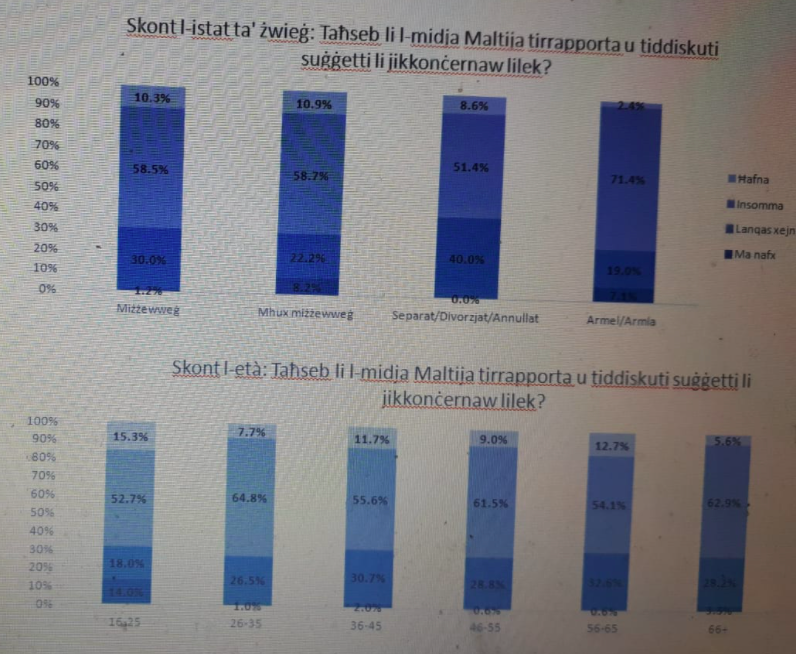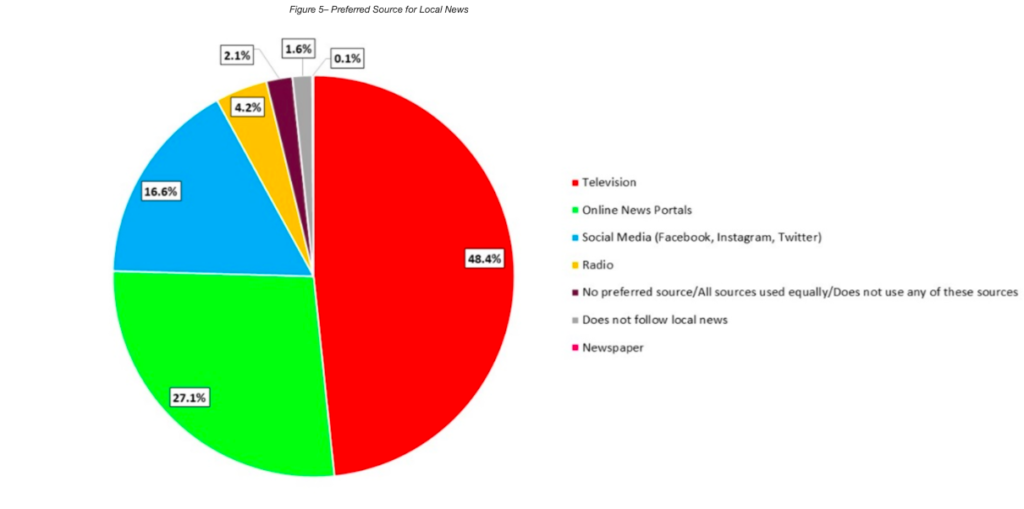IN NUMBERS: How Facebook Decimated Print And TV News In Malta

Malta’s news landscape has changed radically in recent years, with a recent national survey highlighting just how bad the situation has got for newspapers and TV.
These figures on the country’s news consumption habits emerge from a survey conducted by statistician Vincent Marmara among a sample of 1,064 adults as part of President George Vella’s recent ‘State of the Nation’ conference.
Here’s a breakdown of what the survey found.

Statistician Vincent Marmara presenting his survey findings
1. Facebook feeds are now Malta’s most popular source of news by far
Television, long renowned as the king of news, has been dethroned by social media. Asked where they get their news from, 72% of respondents said they follow links to news portals from their Facebook news feeds while 58% said they watch TV news.
Meanwhile, 42% said they directly visit online portals (as opposed to article links popping up on their Facebook feeds), 30% said they listen to radio news, 18% said they get their news from their friends’ Facebook pages and groups, and 18% said they get their news from third parties.
Only 1% of respondents said they don’t follow the news at all.

2. Very few people read newspapers
A mere 3% of respondents said they read newspapers, which will come as a huge blow for the country’s print news industry. Based on the most recent national statistics, which estimates the Maltese adult population at 441,186, only around 13,000 people read newspapers at all.
Malta has four daily newspapers (Times of Malta, The Malta Independent, L-Orizzont and In-Nazzjon), one biweekly paper (MaltaToday) and six Sunday papers (Sunday Times of Malta, Malta Independent on Sunday, MaltaToday, Il-Mument, It-Torċa, and Kullħadd), and the survey shows they’re competing for a very small market.
Age patterns show newspapers are most popular among people aged 26-35 (6.2% of respondents said they read them) and people older than 66 (6.1%). Readership is 2% or lower among all other age cohorts, while not a single 16-25 year old said they read newspapers.
In terms of formal education, newspapers are most popular among people with a tertiary level of education (5.7%); only 1.9% of people with a primary level of education, 2.1% with a secondary level and 1.3% of people with a post-secondary level read newspapers.

3. Only 2% of 16-25-year-olds watch the news on TV
Television is a rapidly dying medium among Maltese youth, with a mere 2% of respondents aged between 16-25 stating that they get their news from TV.
This will come as a major warning sign to Malta’s TV news operators – the state broadcaster TVM and the political party propaganda stations ONE and NET, who are clearly not managing to reach future generations through traditional media.
In comparison, 98% of youths in this age cohort get their news from articles on their Facebook feeds, 43.3% from their friends’ pages and groups and 39.3% directly from online portals

5. And there’s a clear age trend among TV viewers
A clear pattern emerges from the survey: the older you are, the more likely you are to watch the news on TV, and the younger you are the more likely you are to scroll through your news feed.
From 2% among 16-25-year-olds, TV news consumption increases to 32% among 26-35 year olds, 48.8% among 36-45-year-olds, 76.4% among 46-55-year-olds, 84.5% among 56-65 year olds, and 94.9% among people over 66.
Conversely, Facebook news feed consumption declines by age – from 98% among 16-25-year-olds, it shrinks to 90.7% among 26-35-year-olds, 87.8% among 36-45-year-olds, 76.4% among 46-55-year-olds, 52.5% among 56-65-year-olds, and 36.9% among people over 66.
Yet this still makes Facebook news the third most popular news source among the elderly, behind TV and radio.
There’s also a formal education trend – 98.1% of people with a primary level of education get their news from TV, declining to 84.6% among people with a secondary level of education, 40.7% among people with a post-secondary level, and 32.3% among people with a tertiary level.

6. Video did NOT kill the radio star
Interestingly, 4% of youths aged between 16 and 25 said they listen to the news on the radio, which is double the number of people in that age group who watch the news on TV.
Just like TV, radio news popularity increases with age but at a much slower rate, reaching a high point of 59.3% among people older than 66.

7. Elderly people least pleased with the news they follow
Asked if the media reports and discusses topics that interest them, the majority of all respondents (59%) said ‘insomma’ (so and so), while 28% said ‘not at all’, 10% said ‘very’ and 3% said they don’t know.
Interestingly, the age cohort which responded with ‘very’ most often was the 15-25-year-olds (15.3%) while the 66+ cohort – people most likely to get their news from party-owned propaganda stations or TVM – was the least likely to respond this way (5.6%).
Unlike the TV and Facebook news feed viewership, there isn’t a clear age trend though. For example, only 7.7% of people aged 26-35 said the news they follow is relevant to them, a percentage which increases to 11.7% among 36-45-year-olds.
Displeasure at the news they follow is highest among 56-65-year-olds (32.6%), followed by 36-45 year-olds (30.7%), 46-55-year-olds (28.8%), 66+-year-olds (28.2%), 26-35-year-olds (26.5%) and 16-25 year-olds (18%).

8. Some contrasts emerge with the Broadcasting Authority’s studies
Prior to Marmara’s survey, Malta’s news consumption habits have largely been assessed through the Broadcasting Authority’s regular audience surveys. However, some discrepancies have emerged between the two of them.
The most recent BA survey, carried out in December 2020, found that TV was the most favoured news source of 48% of respondents, compared to 27.1% who favour online news and 16.6% who favour social media.
Yet the questions in both surveys were phrased differently – while the BA asked people to pick a single favourite news source, Marmara allowed them to choose more than one option, therefore assessing the public’s habits rather than their preferences.
Also, the BA listed ‘social media’ as a single entity, while Marmara broke this category down into news articles found on social media feeds and information gleaned from friends’ pages and groups.

The Broadcasting Authority's most recent audience survey
There’s no getting away from it – Malta’s news consumption habits have undergone rapid change in recent years. Rather than purchasing their favourite paper or a TV subscription or even visiting news websites, most people now expect the news to come to them at maximum convenience – on an app (mostly Facebook) that is used for multiple functions.
While this is a global phenomenon, the increasing popularity of social media at the cost of TV has special relevance for Malta, whose TV stations are controlled by the state and political parties.
It’s clear that they can no longer completely control the flow of information, a power that has now shifted to social media platforms and the secret algorithms which dictate what people see and don’t see.
And while there’s a lot to be said about the way Facebook arbitrarily controls news feeds and blocks certain content, its decentralisation of information from the political powers that be can only be good news for Malta.